Have you been disappointed with the chewy, dense texture of roasted pumpkin seeds? Or maybe they give you a stomach ache? Then, you’re going to LOVE my delicious soaked & dehydrated pumpkin seeds!
While it may seem counterintuitive, the soaking action is an often forgotten about step and where the magic happens. Not only that, but dehydrating the seeds (instead of roasting) maximizes the nutritional value! A win-win.
In this article, I’ll show you step-by-step how to make these soaked & dehydrated pumpkin seeds along with some fun spice combinations. You’re going to love it! Don’t have a dehydrator? No worries. I have some tips for you, too!
*Disclosure: This post may contain affiliate links to products (including Amazon). I’ll earn a small commission if you make a purchase through my link, at no additional cost to you! Regardless, I only link to products that I personally use on our homestead or believe in.
Why You Should Make Soaked & Dehydrated Pumpkin Seeds
Of course pumpkin seeds are delicious to munch on (that’s a given!), but there are lots of other benefits, too! Taking the extra steps to soak them and utilize a low heat dehydration method really is a game changer. Plus, there are other benefits to making these soaked & dehydrated pumpkin seeds such as putting money back in your pocket and reducing waste in landfills.
Soaking & low-heat makes them more digestible
All seeds contain an anti-nutrients called phytates that inhibit proper absorption of certain nutrients like iron, zinc, magnesium and calcium. Soaking the seeds disables these anti-nutrients and unlocks their nutritional power. Don’t rush it by skipping this step!
The other benefit of soaking is that enzymes are activated, which help us digest the seeds properly. However, if the seeds are roasted at high temperatures, these enzymes are destroyed. Utilizing my method of low-heat dehydration preserves these beneficial enzymes and your gut will thank you for it!
Our ancestors used to soak nuts, seeds, grains and beans regularly. Unfortunately, in our modern world of convenience, this practice has nearly been forgotten. It’s time to get back to the basics!
Highly nutritious snack
When prepared properly, pumpkin seeds are loaded with nutrients such as protein, healthy fats, fiber, vitamin E, magnesium, potassium, phosphorus, zinc, manganese, iron, calcium, and copper. What a list, huh?
Pumpkin seeds have also been shown to offer the following health benefits:
- Reduce inflammation
- Protect against microbial infections
- Support the liver
- Anti-cancer effects
- Hair growth and wound healing
- Reduce the risk of diabetes
- Protect against prostate disorders
Save Money
Buying roasted pumpkin seeds is expensive, especially right now with the crazy food prices! A 2 lb bag is a whopping $23! Instead, you can buy a simple packet of seeds for $5 and end up with TONS of seeds, not to mention 100+ pounds of pumpkin flesh for soup, pies, muffins, you name it!
There are so many different types of pumpkin varieties out there, but my favorite is cinderella. They are stunning. delicious and very easy to grow. You can even use the outer shell as a soup tureen!
Reduce waste
Sure, it’s fun to carve pumpkins for Halloween, but then what? Did you know that 1 billion tons of pumpkins go into our landfills every single year? Absolutely appalling. Pumpkins are an excellent food source and definitely don’t toss those precious seeds out! If you can’t utilize all parts of the pumpkin, please give it to your chickens or compost bin… not your trash.
Dehydrated Pumpkin Seeds Recipe
Woo hoo! We’ve come to the fun part. Let’s make some delicious soaked & dehydrated pumpkin seeds!
Tools
- Knife
- Colander
- Spoon
- Tea towel
- Measuring cups & spoons
- Glass bowl
- Small pot (for melting coconut oil, if using)
- Dehydrator
- Storage container
The Homesteading RD's Product Picks | |
This is the exact dehydrator the I use an love! SIZE: 9-trays and 15 square feet of drying space provides extra-large capacity | |
This is the upgraded model of the one above and features a timer! Super nice! SIZE: 9-trays and 15 square feet of drying space provides extra-large capacity | |
Ingredients
- Fresh pumpkin seeds
- Oil of your choice: Cold-pressed coconut oil (melted), extra virgin olive oil, cold-pressed avocado oil, etc.
- We are using a low heat cooking method in the dehydrator, so unsaturated fats like EVOO are a great choice here. You can learn more about fats for cooking in my article: The Saturated Fat Controversy
- If you decide to roast them in the oven, skip the EVOO.
- Spices (add to taste):
- Sea Salt – I like Redmond’s Real Salt because it’s mineral rich, has no anti-caking agents, and sourced locally in the USA!
- Harvest blend: cinnamon, cloves, nutmeg, maple syrup, etc.
- Savory blend: garlic, smoked paprika, cumin, chili powder, cayenne, etc.
The Homesteading RD's Product Picks | |
Unlike other sea salts, Real Salt is never heat processed, never stripped of its natural components, and contains no additives or anti-caking agents. Also, it's mined in the USA so you can support local rather than buying imported salt. | |
This organic, cold-pressed olive oil is rich in heart-healthy monounsaturated fat and natural antioxidants. This unrefined oil exceeds the stringent quality standards set by the International Olive Council. | |
How to make dehydrated pumpkin seeds
Step 1: Harvest your pumpkin (or buy one from a local farmer’s market or CSA)
Harvesting your pumpkin at the right time is essential to ensuring that you have mature seeds for dehydrating. You know that your pumpkin is ready to harvest when two things happen:
- The stem begins to shrivel and dry
- The skin is toughening up
I typically just let my pumpkins go until we have a frost in the forecast, then harvest right before it hits. If you wait until after a frost, some frost damage may occur and will limit how well your pumpkin does in long-term storage. Resist the urge to carry it by its stem; it will likely break off. You can learn more about my harvesting tips here on Instagram.
There are so many different types of pumpkin varieties out there, but my favorite is cinderella. They are stunning. delicious and very easy to grow. You can even use the outer shell as a soup tureen!
Step 2: Remove and clean the pumpkin seeds
Cut open the top of the pumpkin if you plan to carve it for Halloween. If you aren’t planning on carving, I find it’s easiest to just cut the pumpkin in half. Next, pull out all of the seeds using your hands. I find that the seeds come out cleaner this way vs using a spoon.
Separate the seeds from the fibrous pulp using your fingers. Place the seeds in a colander and rinse well under cool running water until no longer slimy. They’ll still be slippery, but we want to avoid residual pumpkin goo.
Pro tip: make sure to toss the discarded pumpkin pulp out to your chickens! They will LOVE it! If you don’t have chickens, add it to your compost pile. You can learn more about composting in my article The Best Compost for your Vegetable Garden.
Step 3: Soak the pumpkin seeds
Mix up a salt water brine of 1 Tbsp of salt per 4 cups of water. Place the clean pumpkin seeds in a glass bowl and cover with the salt water brine. Allow to soak for 12-24 hours, stirring occasionally.
Don’t skip this step! The soaking action activates its natural enzymes while reducing anti-nutrients, both of which will help you digest them better. It also makes them more crispy – trust me! I did an experiment comparing soaked vs unsoaked and the soaked really took the cake.
Step 4: Dry the pumpkin seeds
After soaking, drain in a colander (don’t rinse!). Spread the seeds out evenly on a tea towel laid on your counter to air dry for an hour or two. This step makes sure that your pumpkin seeds end up nice and crispy. Pro tip: Avoid using paper towels, as they will stick to the seeds as they dry.
Step 5: Season the pumpkin seeds
Return the pumpkin seeds to a bowl and toss with the oil of your choice until fully coated. If using coconut oil, gently melt it first in a small pot. I prefer to use olive oil due to its extensive health benefits when used for low heat cooking.
Then, mix in your seasonings. I never measure and providing measurements isn’t all that helpful anyway because every pumpkin has a different number of seeds. Just eyeball it! Worst case scenario, you over-do it and have to rinse the seeds and start over. You’ve got this!
Which seasonings to use?
It all depends on your taste preferences, but always add salt! If you prefer the traditional “fall” flavors, try nutmeg, cinnamon, and/or cloves. We prefer savory over sweet in our household, so I like to use salt, cumin, smoked paprika and chili powder. YUM!
Step 6: Dehydrate the pumpkin seeds
Spread seasoned pumpkin seeds in a single layer on the dehydrator trays. Set your dehydrator at 115 degrees and let it run for 12-24 hours, checking occasionally. About 18 hours is about perfect for me. Once done, let cool completely before storing in an air-tight container.
You know they’re done when they have a satisfying crunch! If you’re really, really missing that roasted flavor, you can pop them in the oven briefly at 300 degrees for 5-10 min.
Want to see me make these in action? Check out my reel on Instagram!
How to Store Dehydrated Pumpkin Seeds
As long as the pumpkin seeds are fully dried, they will store for a long time! A great way to preserve your harvest and ensure some tasty treats throughout the winter months.
Store the dehydrated pumpkin seeds in a clean, airtight container placed in a cool, dark location for up to 3 months. I love to use wide-mouth mason jars since I always have a bunch on hand for canning.
Monitor for any signs of mold growth; if this occurs, toss them out. You can also freeze the pumpkin seeds for up to a year!
How to Use Dehydrated Pumpkin seeds
These soaked & dehydrated pumpkin seeds are such a versatile item to have in your pantry. They can be incorporated into full meals or simply used as a snack. Here are some easy ways to incorporate them into your daily intake:
- Topping for a salad
- Mix into granola
- Sprinkled on soup
- Snack on its own!
FAQ
Is soaking necessary?
As a dietitian who specializes in gut health, I believe that soaking is necessary to ensure proper digestion and maximize nutrient absorption. However, can you eat non-soaked seeds? Sure, and many people do! They aren’t poisonous; You just might not digest them very well, nor reap the full benefits from them.
Can I use my oven instead of a dehydrator?
Yes, you can. However, most ovens won’t go below 170 degrees F, which is much higher than my recommended dehydrator setting of 115 degrees F. Bake the pumpkin seeds for 1-2 hours, stirring occasionally. You know they are done when they have a satisfying crunch!
On the fence on whether to buy a dehydrator or not? A dehydrator is one of our most used tools on our homestead! Once you have one, you’ll never be able to go back! Mine is running pretty much non-stop through the growing months. I dehydrate things like herbs, beef jerky, chicken liver & heart dog treats, medicinal herbs, pumpkin seeds, entire emergency meals, and much more! You won’t regret it.
The Homesteading RD's Product Picks | |
This is the exact dehydrator the I use an love! SIZE: 9-trays and 15 square feet of drying space provides extra-large capacity | |
This is the upgraded model of the one above and features a timer! Super nice! SIZE: 9-trays and 15 square feet of drying space provides extra-large capacity | |
What if I want roasted pumpkin seeds?
If you really have a craving for that roasted flavor, you can achieve this by baking the pumpkin seeds in your oven. Simply toss in melted coconut oil (we want a saturated fat here since this is high-heat cooking) and seasonings. Then, roast on a sheet pan at 350 degrees F for 12-15 min, stirring occasionally. However, this higher heat will destroy the enzymes in the seeds, making them harder to digest.
Can I use this recipe for butternut squash seeds?
Absolutely! You can use the seeds of any type of winter squash in my soaked & dehydrated pumpkin seed recipe. The seeds are typically smaller than pumpkin seeds, so you may not need to dehydrate them for as long. Start checking on them at 8-12 hours.
Other Food Preservation Recipes You’ll Love
- Dried Radishes for Winter Storage
- No Cook Refrigerator Pickles (Quick!)
- Fermented Turnips Recipe (Sauerruben)
Final Thoughts
If you have a few pumpkins on hand, don’t miss the opportunity to make these soaked & dehydrated pumpkin seeds! They are loaded with nutrition and highly digestable compared to other high-temperature roasted recipes out there. While it might take a bit more time, it’s well worth the wait. Your body will thank you! Enjoy!
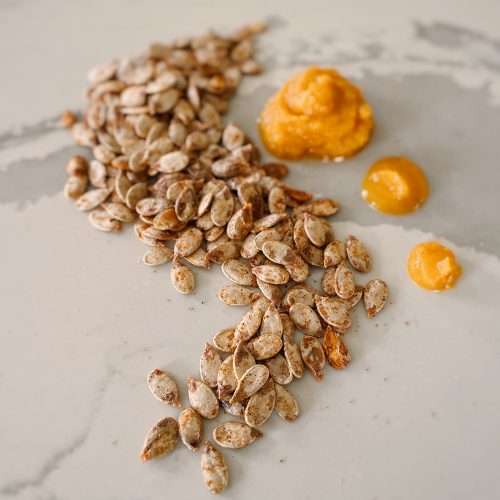
Delicious Soaked & Dehydrated Pumpkin Seeds
Equipment
Ingredients
- Fresh pumpkin seeds
- Oil of your choice Cold-pressed coconut oil (melted), extra virgin olive oil, cold-pressed avocado oil, etc.
- Sea salt I like Redmond's Real Salt
- Spices of your choice Harvest blend: cinnamon, cloves, nutmeg, maple syrup, etc.
Savory blend: garlic, smoked paprika, cumin, chili powder, cayenne, etc.
Instructions
- Harvest your pumpkin (or buy one from a local farmer’s market or CSA)
- Cut open the pumpkin and pull out all of the seeds using your hands. Separate the seeds from the fibrous pulp using your fingers.
- Place the seeds in a colander and rinse well under cool running water until no longer slimy.
- Mix up a salt water brine of 1 Tbsp of salt per 4 cups of water. Place the clean pumpkin seeds in a glass bowl and cover with the salt water brine. Allow to soak for 12-24 hours, stirring occasionally.
- After soaking, drain in a colander (don’t rinse!). Spread the seeds out evenly on a tea towel laid on your counter to air dry for an hour or two. This step makes sure that your pumpkin seeds end up nice and crispy.
- Return the pumpkin seeds to a bowl and toss with the oil of your choice until fully coated. If using coconut oil, gently melt it first in a small pot. I prefer to use olive oil due to its extensive health benefits when used for low heat cooking.
- Then, mix in your seasonings. I never measure and providing measurements isn’t all that helpful anyway because every pumpkin has a different number of seeds. Just eyeball it!
- Spread seasoned pumpkin seeds in a single layer on the dehydrator trays. Set your dehydrator at 115 degrees and let it run for 12-24 hours, checking occasionally. 18 hours is about perfect for me.
- Let cool completely, then store the dehydrated pumpkin seeds in a clean, airtight container placed in a cool, dark location for up to 3 months.
Nutrition

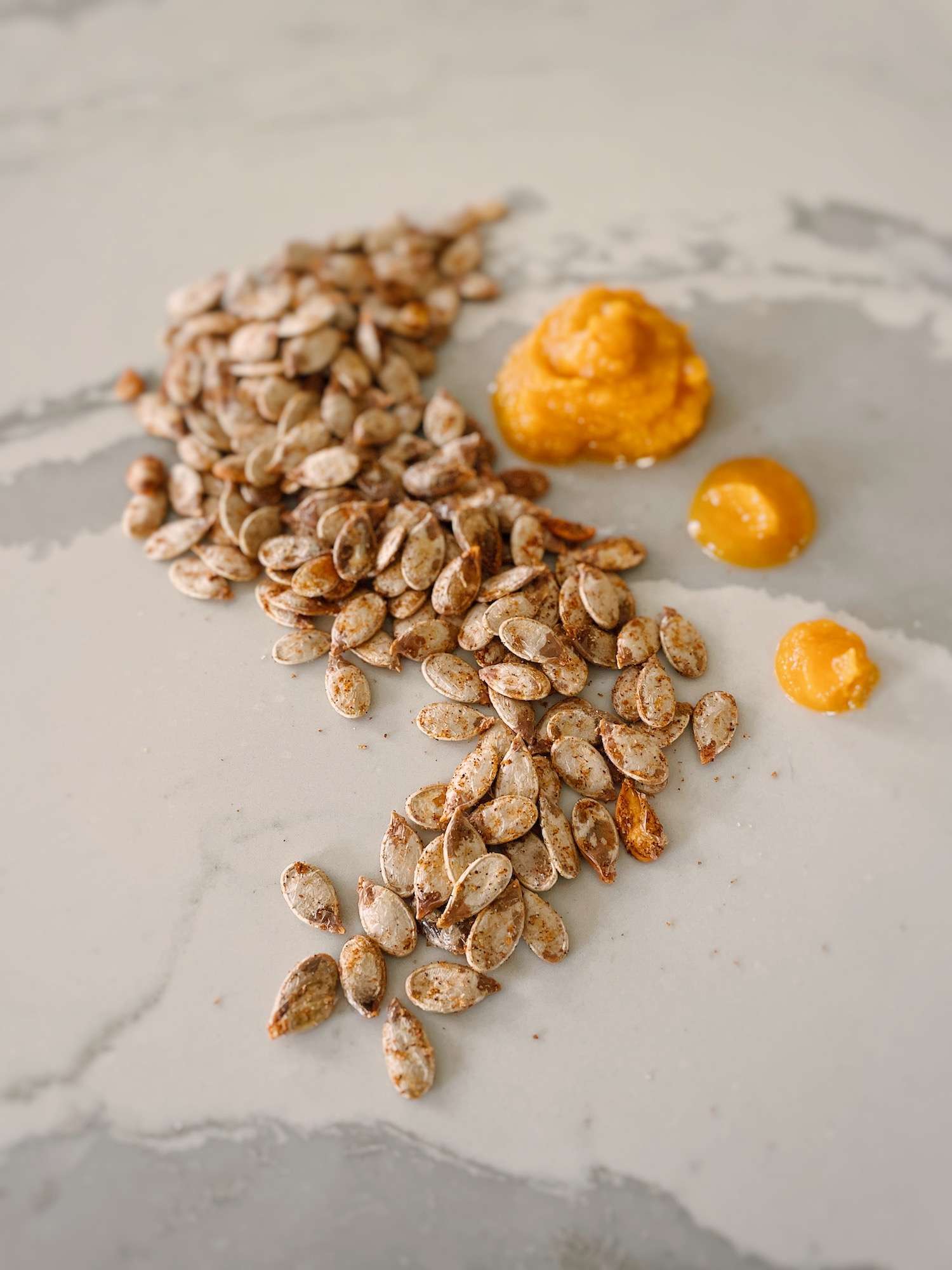
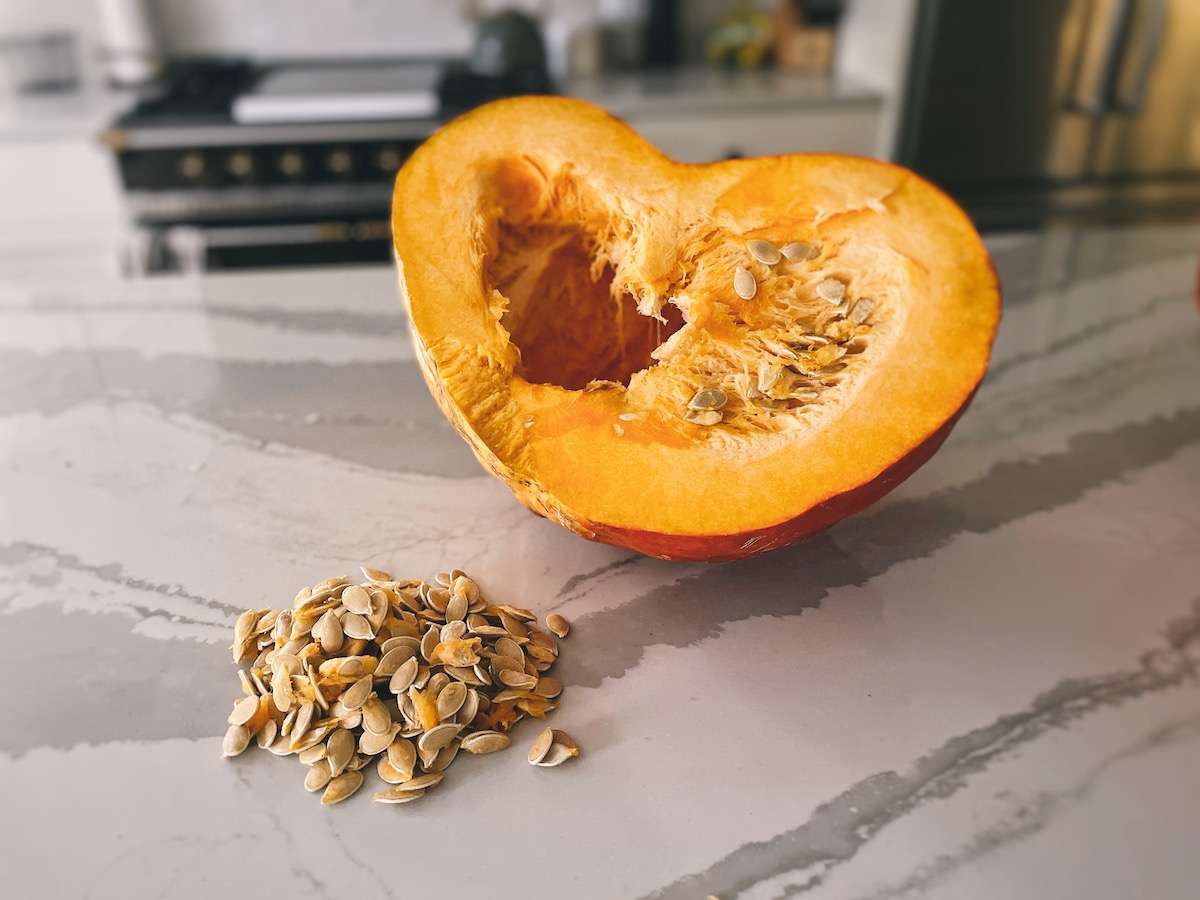




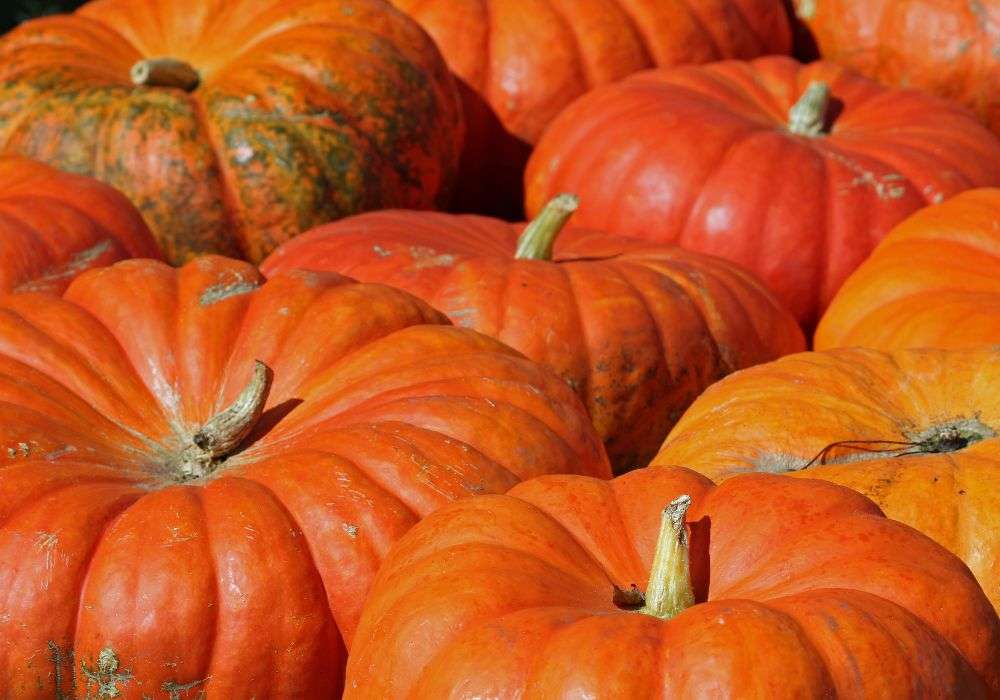
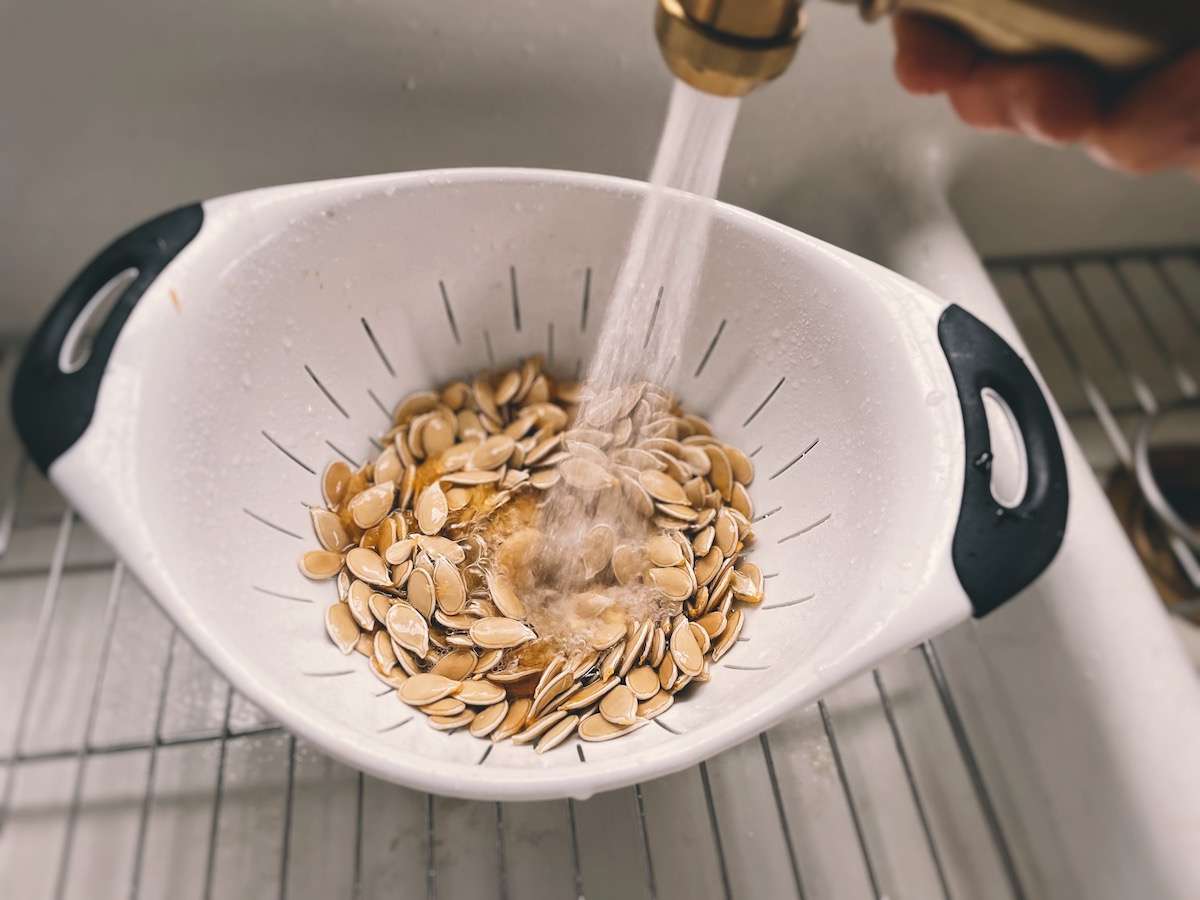
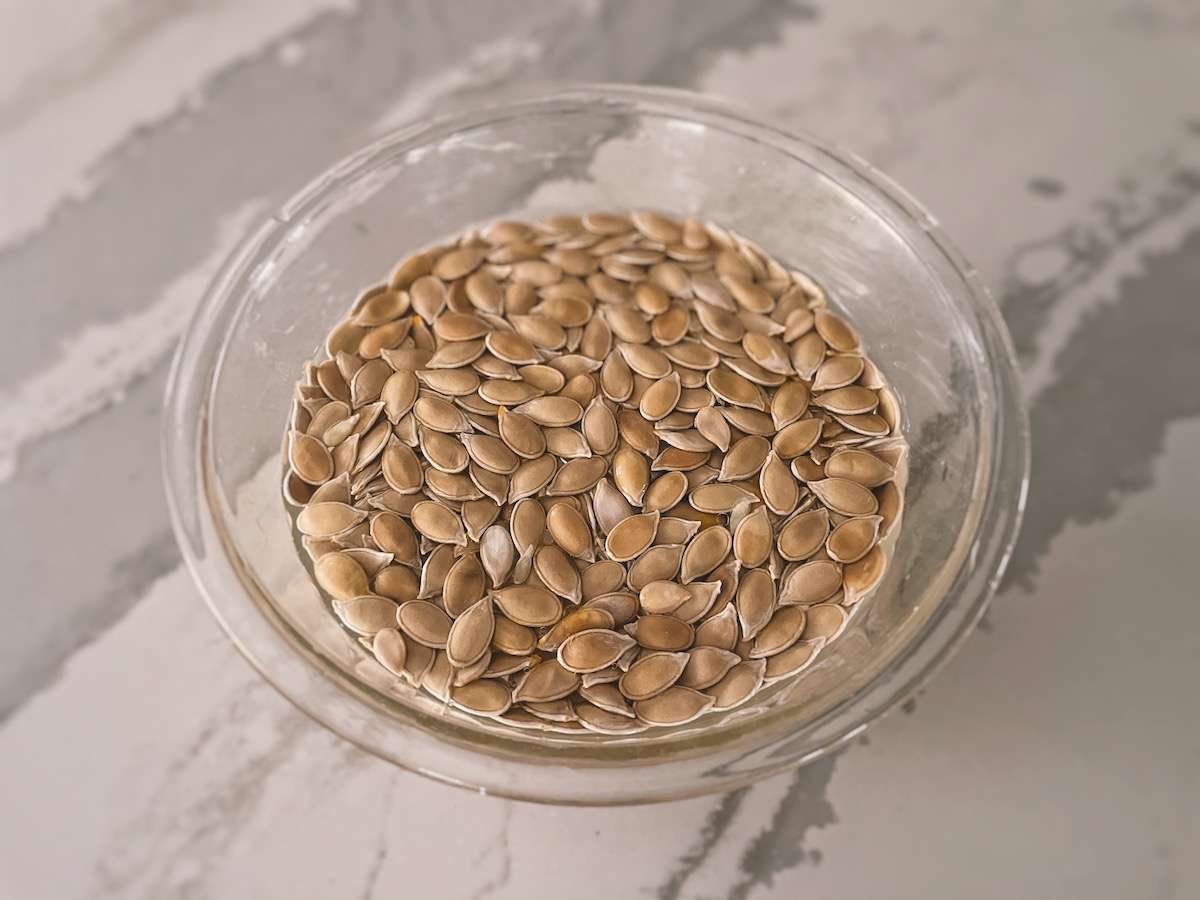
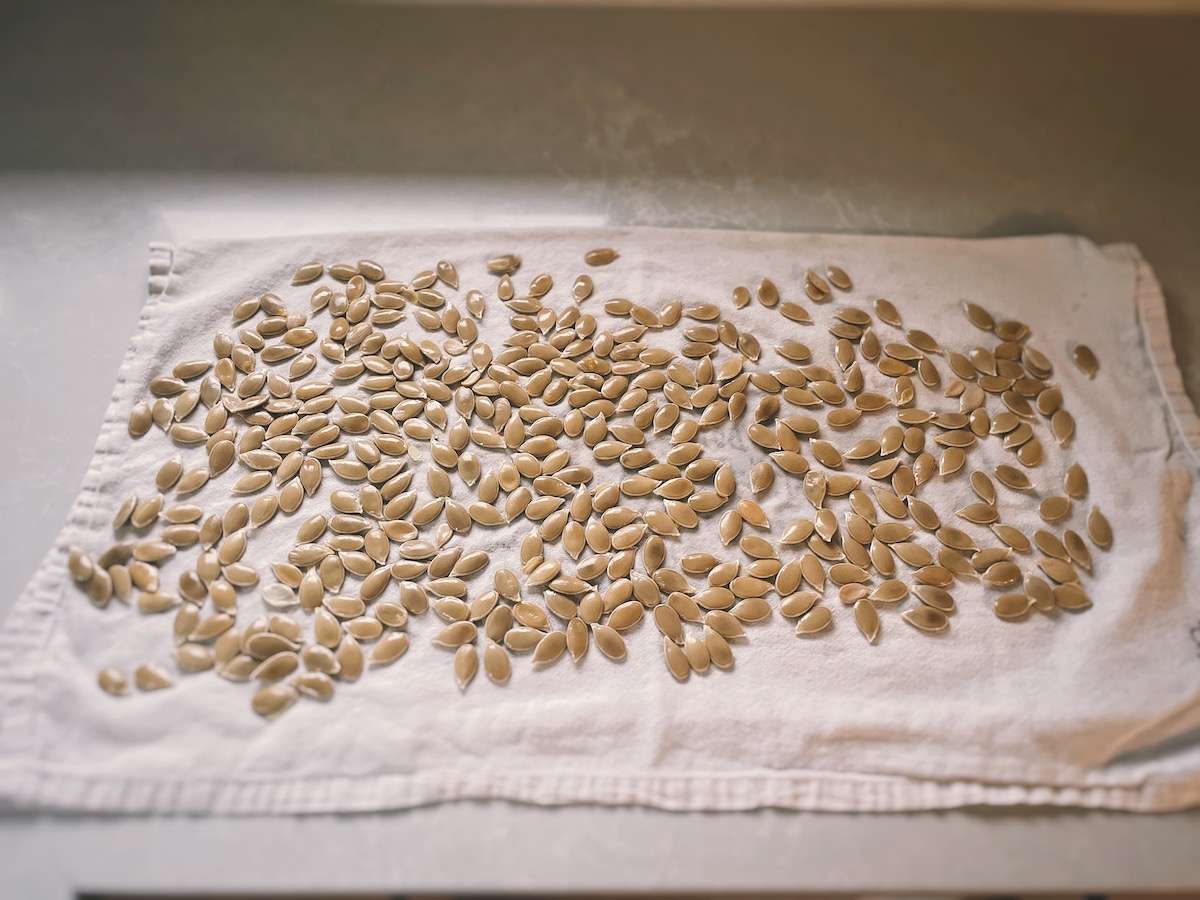
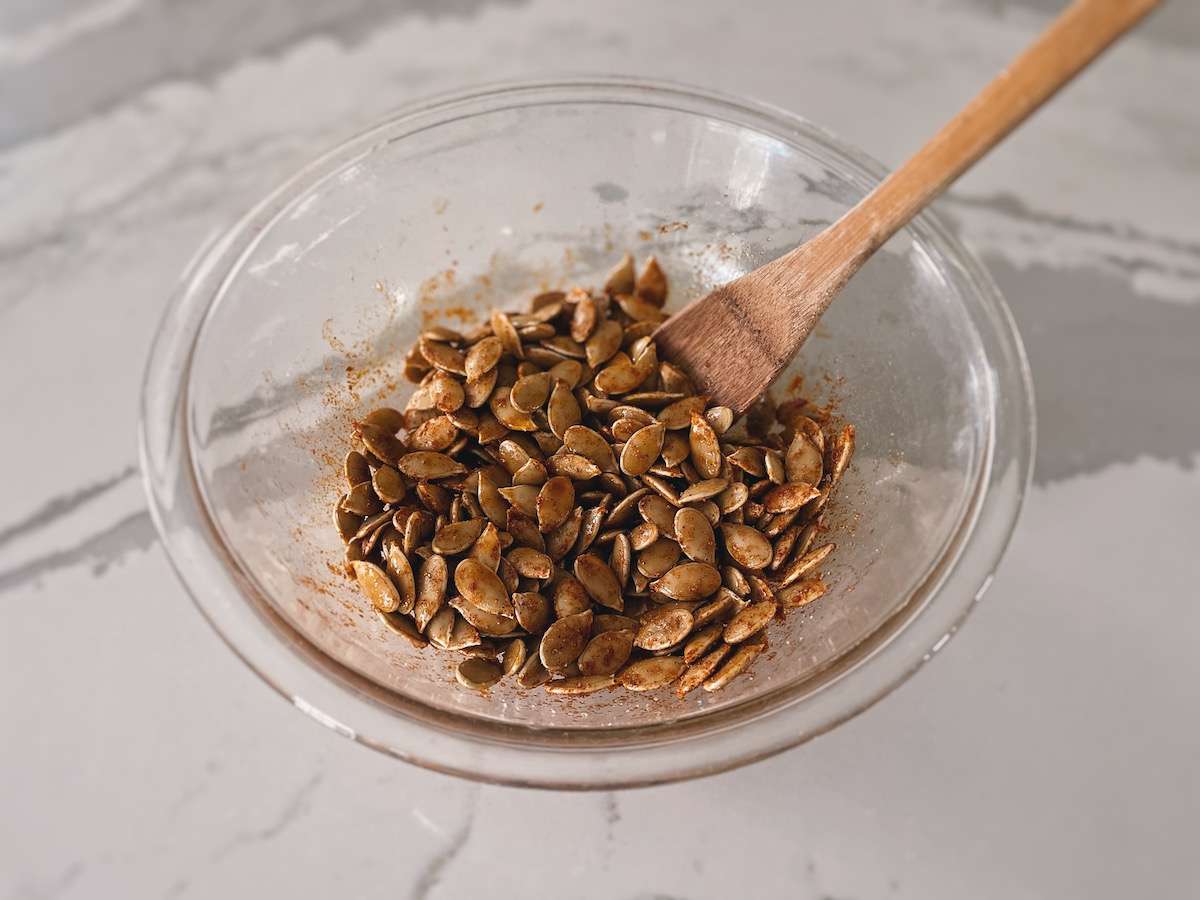
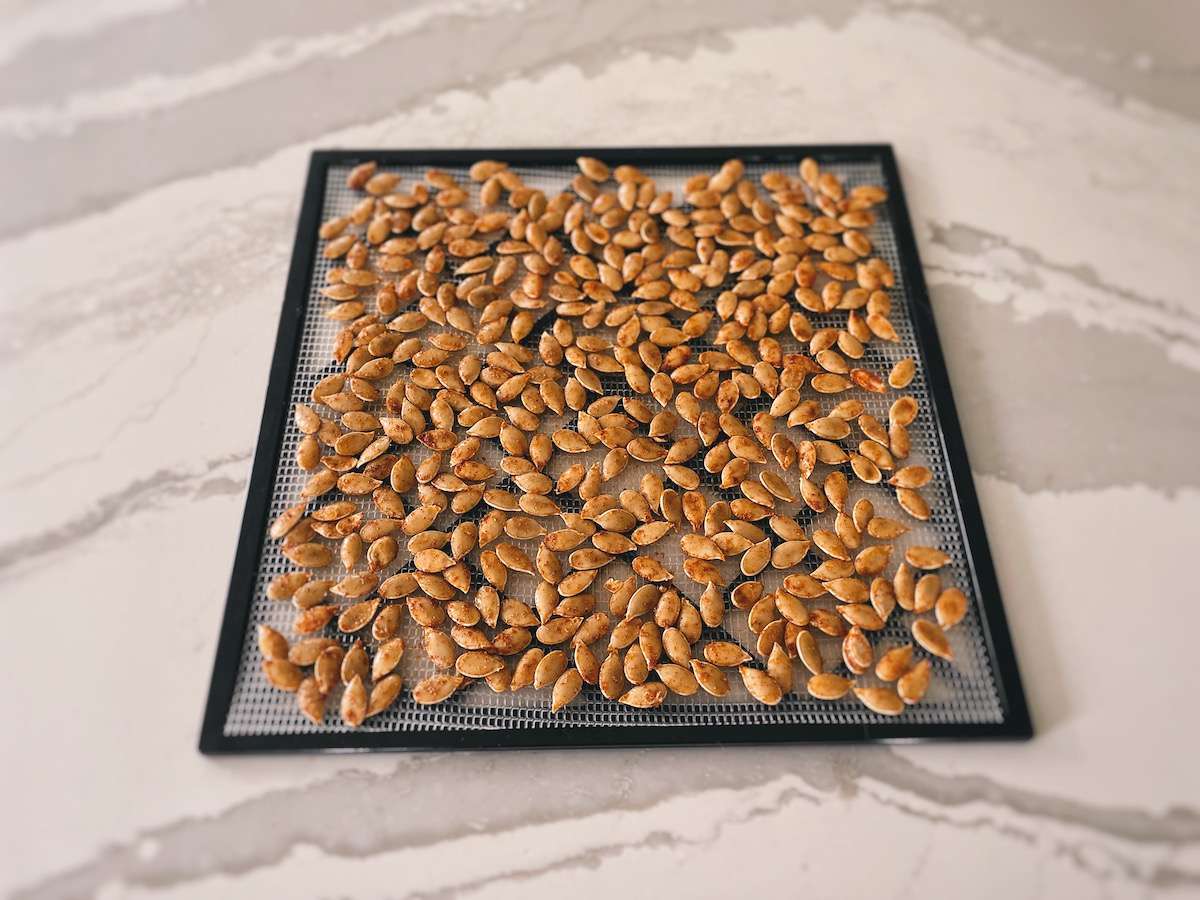

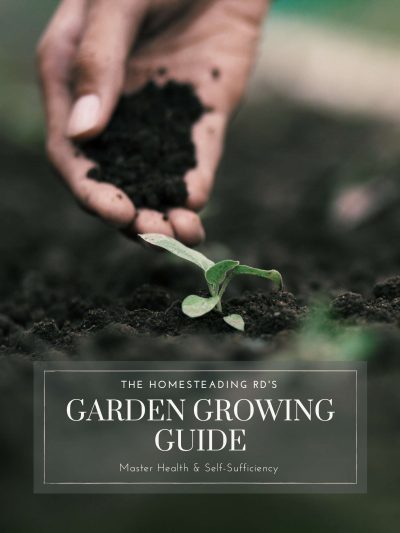
Can dehydrating be gone without the use of oil? I believe there is no nutritional benefit to using any kind of oil. Thanks
I soak most of my seeds before eating them but I have never thought to soak pumpkin seeds – duh! Thank you for this recipe!
What a great idea! I think my little ones would love to help too!
I bet they’d love it!
Can’t wait to give these a try
You’re going to love them!
This is good stuff👌🏻 Info, process, recipe, all of it! 👍🏻 Gonna have to give this a try. Love the dehydrator!
Enjoy and let me know what you think! 🙂
I’ve never thought about doing it this way! Definitely going to give it a try!
It’s SO much better! Crunchy and not chewy, plus easier to digest 🙂